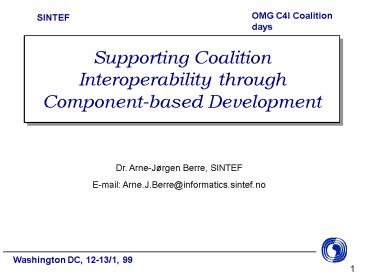Supporting Coalition Interoperability through Componentbased Development PowerPoint PPT Presentation
1 / 15
Title: Supporting Coalition Interoperability through Componentbased Development
1
Supporting Coalition Interoperability through
Component-based Development
Dr. Arne-Jørgen Berre, SINTEF E-mail
Arne.J.Berre_at_informatics.sintef.no
2
Overview
- What is Coalition Interoperability ?
- What is Component Based Development ?
- OMG Support for Component-based development (CC)
- OMG Support for Interoperability Specifications
(UML) - OMG - Using ISO RM-ODP viewpoints
- BOI - UML profile for EDOC - OMG RFPs
- Norwegian UML/ODP extension to C4ISR AF
- Conclusion - Supporting Interoperability
Component Technologies, UML and ISO RM-ODP
3
Coalition Interoperability
Coalition interoperability refers to the
ability of coalition forces to jointly interact
and cooperate - and for their digital systems to
support this through 1) exchange of relevant
information about the situation and plans and 2)
cooperatively, over networks, run software
capable of manipulating such information.
4
Interoperability (definition)
- Two components X and Y can interoperate (are
interoperable) if X can send requests Ri for
services to Y, based on a mutual understanding
of Ri by X and Y, and if Y can similarly return
responses Si to X. (Brodie 1992) - i.e. operate together
- Semantic interoperability -gt also able to
interpret the intended meaning
5
OMG offerings to support interoperability
- An object-oriented approach
- Use of Components (Corba Components)
- Use of ISO RM-ODP to describe multiple viewpoints
of a complex distributed system - Use of UML as a specification language
- Extensions to UML to support EDOC (Enterprise
Distributed Object Computing)
6
A Component-based approachto interoperability
Object-Oriented principles Encapsulation of
data representation and processing implementation
through well-defined interfaces. Objects might
have the same interface, but different internal
implementations and representations. -gt A need
for agreeing on the interfaces only
- processing (implementation) -
data (representation)
- processing (implementation) -
data (representation)
7
An Interoperable Component
8
CORBA Components(in progress to finish summer
1999)
- A server-side component model for building and
deploying applications - An architecture for defining server components
and their interactions - A packaging technology for deploying binary,
multi-lingual, executables - A container framework for injecting security,
transactions, and persistence - A CORBA container for Enterprise JavaBeans
9
Evolution of the UML
UML 1.1 (Sept. 1997)
Taskon,SINTEF
10
ISO RM-ODP (10746) - in use in OMG domain
specifications
11
ISO RM-ODP based Interoperability Reference model
12
Computational Interoperability
C4I Applications
C4I Applications
C4I Services
C4I Services
IT Services
IT Services
ISI
HTI
CSI
CSI
ISI
HTI
NNI
NNI
Adapted ISO/TC211 Architectural Reference Model
13
OMG Business Object Initiative RFPs (1999)
Similar to work in the European OBOE Esprit
project (97-99)
EDOC - Enterprise Distributed Object Computing
14
Extending C4ISR-AF with ISO RM-ODP and
UML(Norwegian project proposal)
Enterprise viewpoint
High level Enterprise Graphics
Business Entity Model
Organisation Model
Business Process Model
Enterprise Distribution model
Requirement Model
Information viewpoint
System Architecture Model
Computational viewpoint
Entity BO Model
Service Obj Model
Boundary Obj Model
Engineering viewpoint
System Evolution Model
System Distribution Model
Overview and Summary
Technology Model
Integrated Dictionary
Technology viewpoint
Data Storage Model
Test Model
15
Summary
- OMG offers technologies that can help to achieve
Coalition Interoperability - Encapsulation and CORBA focus on interface
protocols - CORBA-components - in progress
- UML - notation for describing models
- ISO RM-ODP useful structure for specifying
models - UML-extensions for Enterprise Distributed Object
Computing - in progress

